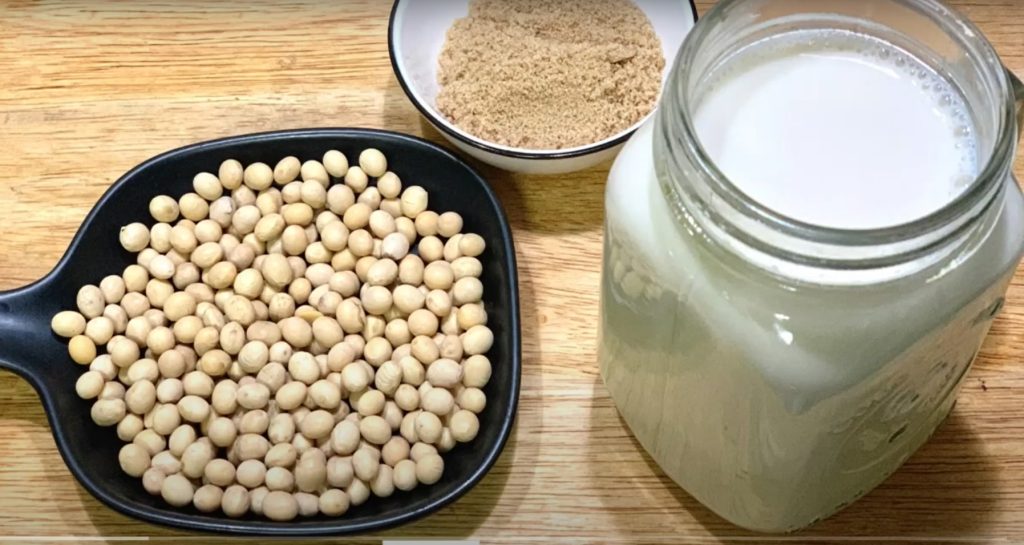
Introduction for Silk Soy Milk
“Embark on a sensory journey with our exquisite rich silt soy milk, where velvety smoothness meets unparalleled richness. Crafted with precision and dedication, this soy milk is a testament to perfection in every sip. Elevate your taste experience and dive into the luxurious essence of soy transformed into a silken elixir. Let’s unveil the secrets behind this sumptuous creation, promising a taste that’s nothing short of divine.”
Ingredients for Silk Soy Milk
- 150g Soybeans (soaked overnight)
- 750ml Water
- 50g Japanese Brown Sugar
Instruction
- Prepare the Soaked Soybeans: Rinse the soybeans thoroughly and place them in a bowl. Cover the soybeans with water and allow them to soak overnight or for at least 8-10 hours. Once soaked, drain and rinse the beans again.
- Blend the Soybeans: In a blender, add the soaked soybeans and 750ml of fresh water. Blend until the mixture becomes smooth and creamy.
- Strain the Soy Milk: Place a nut milk bag, cheesecloth, or a fine-mesh sieve over a large bowl. Pour the blended soy mixture into the bag or sieve to strain out the soy pulp, extracting the liquid. Gently squeeze or press the pulp to extract as much milk as possible.
- Sweeten with Japanese Brown Sugar: Transfer the strained soy milk into a clean saucepan. Heat the soy milk over medium heat. Add Japanese brown sugar to the soy milk and stir continuously until the sugar completely dissolves. Adjust the sweetness according to your preference.
- Cool and Store: Once the sugar has dissolved and the soy milk has reached your desired sweetness, remove it from the heat and let it cool. Transfer the Japanese brown sugar-infused soy milk into a clean, airtight container. Refrigerate and consume within a few days for the freshest taste.
Enjoy the rich, creamy goodness of homemade brown sugar-infused soy milk – a delicious and nutritious beverage that’s perfect for enjoying hot or cold, straight from your kitchen- Silk Soy Milk!
Video for Silk Soy Milk
more Video
History and Story of Silk Soy Milk
The story of silk soy milk traces back centuries, woven into the fabric of ancient Asian cultures and their culinary traditions. Its history is a tale of innovation, health, and a remarkable journey through time.
Dating back to China around 2000 BC, soybeans were first cultivated as a significant crop and utilized for various purposes, including the creation of soy-based foods. Initially, soy milk wasn’t merely a beverage but rather an essential ingredient in a wide array of dishes, playing a pivotal role in the evolution of Asian cuisine.
The process of making soy milk in ancient times involved soaking soybeans overnight, grinding them with water, and then straining the mixture to obtain a milky liquid. This early form of soy milk became a staple among Buddhist monks, who valued it as a nutritious and protein-rich alternative to dairy milk.
Over the centuries, soy milk gained prominence not only in China but also in neighboring Asian countries like Japan and Korea. Its popularity surged as it became an integral part of traditional dishes, offering a versatile ingredient that could be fermented, used in soups, or enjoyed as a beverage.
As global trade routes expanded, soybeans found their way to Japan, where they were embraced with enthusiasm. In Japan, the art of preparing soy milk evolved, and distinct variations emerged, each reflecting regional preferences and techniques. The addition of Japanese brown sugar, renowned for its delicate sweetness and earthy notes, transformed soy milk into a delightful delicacy.
Japanese brown sugar, or “kokuto,” harvested from sugarcane, complemented the nutty flavor of soy milk, adding a nuanced sweetness that captivated palates. The marriage of soy milk and kokuto symbolized a harmonious blend of tradition and innovation, bringing forth a beverage that resonated deeply with Japanese culinary culture.
Throughout the 20th century, soy milk underwent a transformation. It transcended its cultural roots, gaining traction in the West as people sought healthier, plant-based alternatives. In the 1970s, health-conscious individuals embraced soy milk for its low cholesterol content and high protein value, heralding it as a nutritious dairy substitute.
With the rise of veganism and lactose intolerance awareness, soy milk became a household name globally. Its versatility and nutritional benefits made it a preferred choice for those seeking a plant-based lifestyle.
Today, the making of soy milk has been streamlined with modern technology, yet its essence remains rooted in tradition. The process involves soaking soybeans, blending them with water, and then straining the mixture to produce a smooth, creamy liquid. Variations in flavors, such as the incorporation of Japanese brown sugar, continue to elevate soy milk, adding depth and character to its taste profile.
The story of silk soy milk is not just about a beverage; it’s a narrative of cultural exchange, culinary innovation, and health consciousness. From ancient China to modern kitchens worldwide, soy milk’s journey epitomizes the evolution of a humble legume into a globally cherished elixir.
As we savor each sip of silk soy milk sweetened with Japanese brown sugar, we celebrate not just a beverage but a heritage that has stood the test of time—a testament to the amalgamation of tradition, innovation, and the enduring quest for wholesome nourishment.
